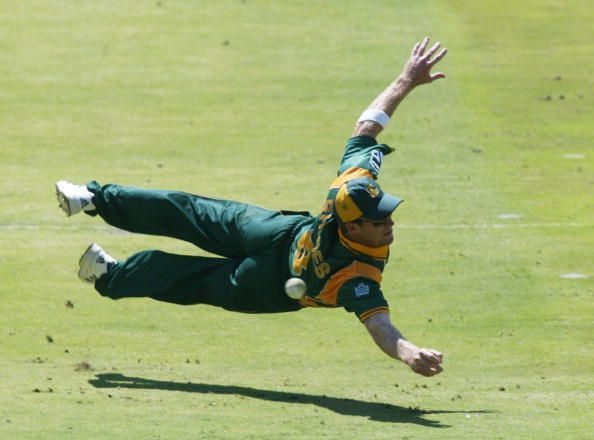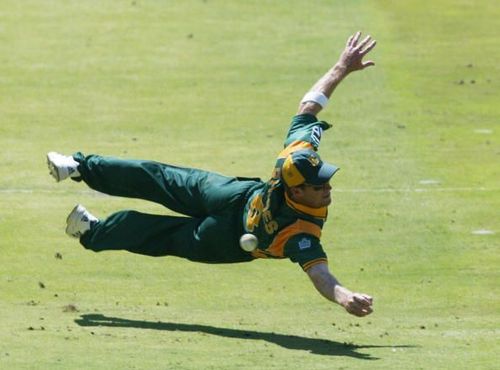
Fielding: The benchmark of excellence

Good fielding and quality catching abilities always add to a team’s overall performance as batting and bowling is not the only criteria to win a cricket match. Good fielding adds beauty and grandeur to the gentleman’s game.
As the saying goes, ‘catches win matches’, it is getting justified day-in-and-day-out as top cricketing teams around the world have been constantly improving on fielding. Traditionally, teams like Australia, New Zealand, England and South Africa have set benchmarks and improved the fielding quality.
Off late, Asian powerhouses like India and Sri Lanka have also have been working on their fielding standards. Needless to say, India particularly has transformed in the fielding department. Gone are the days when the Indian cricketers used to be horrible at fielding.
Under the present captaincy of the mercurial captain Virat Kohli, the Men in Blue: Team India are rated among the best fielding units in world cricket. Players like Virat Kohli, Ravindra Jadeja, Manish Pandey, Umesh Yadav, Rohit Sharma, Shikhar Dhawan, KL Rahul, etc. are tremendous fielders and save 20-25 runs in a 50-overs match.
Apart from these guys, former captain Mahendra Singh Dhoni has revolutionised wicket-keeping standards through his immaculate timing, hand-eye coordination speed and overall reading of the game. Records speak volumes, for, the amount of catches ‘Mahi’ has taken: umpteen number of those have been spectacular ones.
Apart from India, teams like Australia has quality fielders like Glenn Maxwell, Chris Lynn, D’Arcy Shot, David Warner, Steve Smith, Shaun Marsh to name a few who are live wires in the field. Likewise, New Zealand has captain Kane Williamson, Trent Boult, Martin Guptill, Tim Southee.
When it comes to quality fielding side, how can we miss the Proteas, who traditionally have been looked upon as the best fielding side in the world courtesy Jonty Rhodes. Who can forget the nearly impossible run out that the South African talisman effected on the bulgy Inzamam-ul-Haq in the 1992 World Cup.
That flying run out by Jonty brought in a paradigm shift the way fielding was done. Post that South Africa was the first team that set the benchmark of being a quality fielding side and have saved almost 20-25 runs in most of the matches they played through their mesmerizing fielding abilities. AB-de-Villiers is highly regarded as the modern-day Jonty Rhodes for his pyrotechnics in the field.
South Africa’s improved fielding forced other teams, particularly Australia to raise their bar in fielding. The results were to see. The Aussies went on to win three back-to-back World Cups: 1999, 2003 and 2007, where ‘The Invincible’ showed the world that though you possess gifted match-winners on your side, it is not without the effort of a good fielder that you can win a cricket match on the field.
With changing times, post the 2007 ODI World Cup, the then newly appointed captain of India, MS Dhoni took a hard stance to raise India’s bar as a fielding unit. Who can forget the gut wrenching losses India had to suffer at the hands of Bangladesh and Sri Lanka.
Thereafter, within few months, a young and new looking Team India won the inaugural T20 World Cup in South Africa which consisted of mostly young players like Rohit Sharma and Robin Uthappa.
The major omissions were Sachin Tendulkar (who gave away his T20 spot to youngsters voluntarily), Rahul Dravid, Sourav Ganguly, Anil Kumble to name a few. No doubt, a lot of questions were raised towards Dhoni prior to the World Cup, which were answered fittingly by the young Team India as they went on to win the T20 World Cup final defeating Pakistan by a close margin of 5 runs.
An Indian fan still gets goose-bumps when that flashback moments reverberate in the mind: S Sreesanth took that match-winning catch holed by Misbah-ul-Haq, fielding at short fine leg. The catch of Michael Hussey by Yuvraj Singh in the semi-finals was also one of the moments of that tournament. The catch taken by Dinesh Karthik to dismiss Graeme Smith was probably the catch of the tournament for India.
Who can forget the Indian version of Jonty Rhodes- Mohammad Kaif, who has orchestrated some impossible catches with the reaction time of less than one second in most of the catches. Alongside Kaif, Yuvraj Singh has also been a pillar of strength in India’s development as a fielding unit over the years: especially the one-handed catches fielding in his favourite position, i.e. point, backward point and short mid-wicket.
Yuvraj put his best fielding effort in the 2011 World Cup final against Sri Lanka when he individually saved a flurry of certain boundaries that were hit in his region inside the 30 yards circle by Tillekaratne Dilshan and Mahela Jayawardene. Yuvraj Singh has been a huge inspiration to the new generation fielding unit led by Virat Kohli, Suresh Raina, Ravindra Jadeja, Manish Pandey, KL Rahul to name a few.
Rahul Dravid is perhaps India’s best fielder at slip cordon in Test Matches as he holds the record for the highest number of catches in Test Cricket i.e. 210. His timing to perfection, discipline, concentration like that of an eagle has led to these number of catches most of which has accounted in India winning some of the famous Test matches.
Dravid is followed by former Sri Lankan captain Mahela Jayawardene who has 205 catches to his name. Former Australian great Mark Waugh comes third with 181 catches. Presently Ajinkya Rahane is the worthy successor to Rahul Dravid at the slip and holds a unique record of taking eight catches in a single innings in the famous Galle Test against Sri Lanka in 2015.
‘Catches win matches’ holds true and has been justified very well as the present generation fielders take nearly impossible catches. India Premier League (IPL) over the years has witnessed some of the best catches in cricket history, particularly ‘catches in partnerships’ where two fielders are involved.
The batsman confidently plays an aerial shot only to find himself being caught at the boundary ropes by an excellent partnership catch. Though on record the catch goes to the latter but the spectators know that the actual efforts were put in by the former. This is like Lionel Messi voluntarily assisting a great goal and passing the ball to Sergio Aguero thereby showing his greatness in assisting skills apart from his goal-scoring prowess.
Another spectacular catch by an Indian was taken in the famous Calcutta Test of 2001. The Test was dominated by VVS Laxman’s monumental 281 and Rahul Dravid’s classic 180, both forging a partnership of 336 runs.
In the 4th innings, a 20-year-old Harbhajan Singh came to the party by becoming the first-ever Indian to take a hattrick in Test Cricket; his victims being Ricky Ponting, Adam Gilchrist and Shane Warne. Warne’s was the hattrick victim where Shiv Sundar Das took a one-handed low catch leaning to his right at short-leg, to a beautiful ball bowled by Bhajji.
Let's hope the players keep setting new benchmarks of fielding in the times to come.